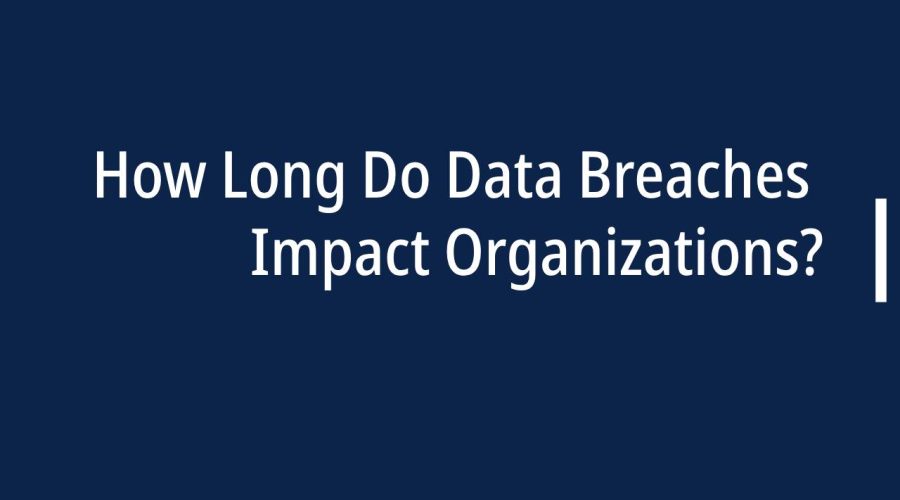Data breaches have become an all-too-familiar headline in the digital age. These security incidents can have far-reaching consequences for organizations, impacting not only their finances but also their reputation, customer trust, and regulatory compliance. In this comprehensive blog, we will explore the lasting effects of data breaches on organizations, examining the timeline of their impact and the strategies for recovery and resilience.
Understanding the Lifespan of a Data Breach
- Immediate Impact: The initial impact of a data breach is often swift and can lead to significant disruptions. This phase can last from a few days to several weeks.
- Short-Term Financial Impact: In the immediate aftermath, organizations may face substantial financial losses, including the cost of incident response, legal fees, and potential fines. Stock prices may dip, affecting market capitalization.
- Customer Trust Erosion: Customer trust can erode rapidly, and in the short term, this may lead to customer churn and reduced revenue.
- Media Attention: The media spotlight can be intense, with negative headlines dominating news cycles. This can last for several weeks, depending on the scale and sensitivity of the breach.
The Ongoing Impact
- Long-Term Financial Consequences: The financial consequences of a data breach can extend well beyond the initial incident. This includes ongoing legal expenses, regulatory fines, and the cost of implementing security improvements.
- Regulatory Scrutiny: Organizations may face regulatory investigations, audits, and ongoing compliance requirements that can persist for months or even years.
- Legal Battles: Class-action lawsuits and litigation can extend the impact of a data breach as cases may take years to resolve.
- Reputation Damage: Rebuilding a tarnished reputation can be a lengthy process. Trust once eroded is challenging to regain, and it may take years to restore an organization’s image.
Data Breach Recovery Strategies
- Improved Security Measures: Organizations must invest in and maintain enhanced security measures to prevent future breaches.
- Data Encryption: Encrypting sensitive data is a fundamental step in protecting information and mitigating the consequences of breaches.
- Employee Training: Employee awareness and training programs should be ongoing to prevent human error and insider threats.
- Incident Response Plans: Developing and regularly testing incident response plans is essential for minimizing the impact of future incidents.
Long-Term Repercussions on Stock Prices
- Stock Price Recovery: Recovering lost stock value can take years, and some organizations may never fully regain their pre-breach stock prices.
- Market Capitalization: Market capitalization can remain lower than it would have been without the breach, impacting the company’s overall valuation.
Customer Trust and Loyalty
- Trust Building: Restoring customer trust is an ongoing effort, requiring transparency, security improvements, and consistent communication.
- Customer Churn: Some customers may never return, leading to long-term revenue losses.
Legal and Regulatory Challenges
- Fines and Penalties: Regulatory fines and penalties can be an ongoing financial burden, lasting until organizations fully comply with data protection regulations.
- Compliance Costs: Maintaining compliance with data protection laws involves ongoing costs for security enhancements and audits.
- Data Protection Officers: Many organizations must appoint Data Protection Officers (DPOs) and ensure their ongoing compliance with regulatory requirements.
Impact on Employee Morale
- Employee Morale: The fallout from a data breach can negatively impact employee morale, as staff may feel responsible or uncertain about job security.
- Employee Retention: Organizations may experience higher turnover rates as a result of employee dissatisfaction and job insecurity.
Long-Term Reputation Management
- Reputation Repair: Reputation management is an ongoing effort, requiring consistent positive actions to outweigh the negative impact of the breach.
- Marketing and PR Efforts: Marketing and public relations campaigns may be needed for years to rebuild the organization’s image.
The Ever-Present Threat of Repeat Breaches
- Repeat Breaches: Organizations that fail to address the root causes of a breach may experience repeat incidents, perpetuating the impact.
- Financial Vulnerability: Persistent breaches can lead to financial vulnerability, making it difficult to invest in growth or innovation.
The Role of Cyber Insurance
- Cyber Insurance: Cyber insurance can help organizations mitigate the long-term financial impact of data breaches by covering various costs.
- Insurance Premiums: After a breach, insurance premiums may increase, creating an ongoing financial burden.
The Evolving Regulatory Landscape
- New Regulations: Regulatory frameworks continue to evolve, introducing new requirements and compliance challenges.
- Data Privacy Laws: Staying compliant with data privacy laws is an ongoing commitment that requires legal and technical resources.
The Need for Proactive Cybersecurity
- Proactive Security: Organizations must adopt proactive security measures, such as threat detection, encryption, and regular security assessments.
- Human Resources: Human resources play an ongoing role in ensuring employee awareness, training, and background checks.
The Growing Threat of Insider Attacks
- Insider Threats: Insider attacks, whether intentional or accidental, are an ongoing threat that requires continuous monitoring.
- User and Entity Behavior Analytics (UEBA): UEBA solutions can provide ongoing insights into user behavior and potential insider threats.
Maintaining Resilience
- Resilience Planning: Organizations must maintain resilience by regularly updating and testing their incident response plans.
- Redundancy: Implementing redundancy and data backup systems can help organizations recover quickly from future incidents.
Conclusion
Data breaches have long-lasting impacts on organizations, ranging from financial consequences and regulatory scrutiny to reputation damage and legal challenges. Understanding the timeline of these effects is crucial for organizations to develop strategies for recovery and resilience. By investing in robust cybersecurity measures, proactive security practices, and ongoing compliance efforts, organizations can mitigate the long-term impact of data breaches and safeguard their future.

Gloria Bradford is a renowned expert in the field of encryption, widely recognized for her pioneering work in safeguarding digital information and communication. With a career spanning over two decades, she has played a pivotal role in shaping the landscape of cybersecurity and data protection.
Throughout her illustrious career, Gloria has occupied key roles in both private industry and government agencies. Her expertise has been instrumental in developing state-of-the-art encryption and code signing technologies that have fortified digital fortresses against the relentless tide of cyber threats.
